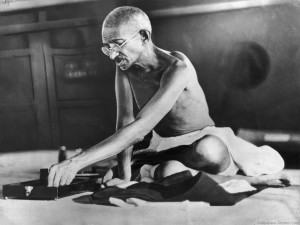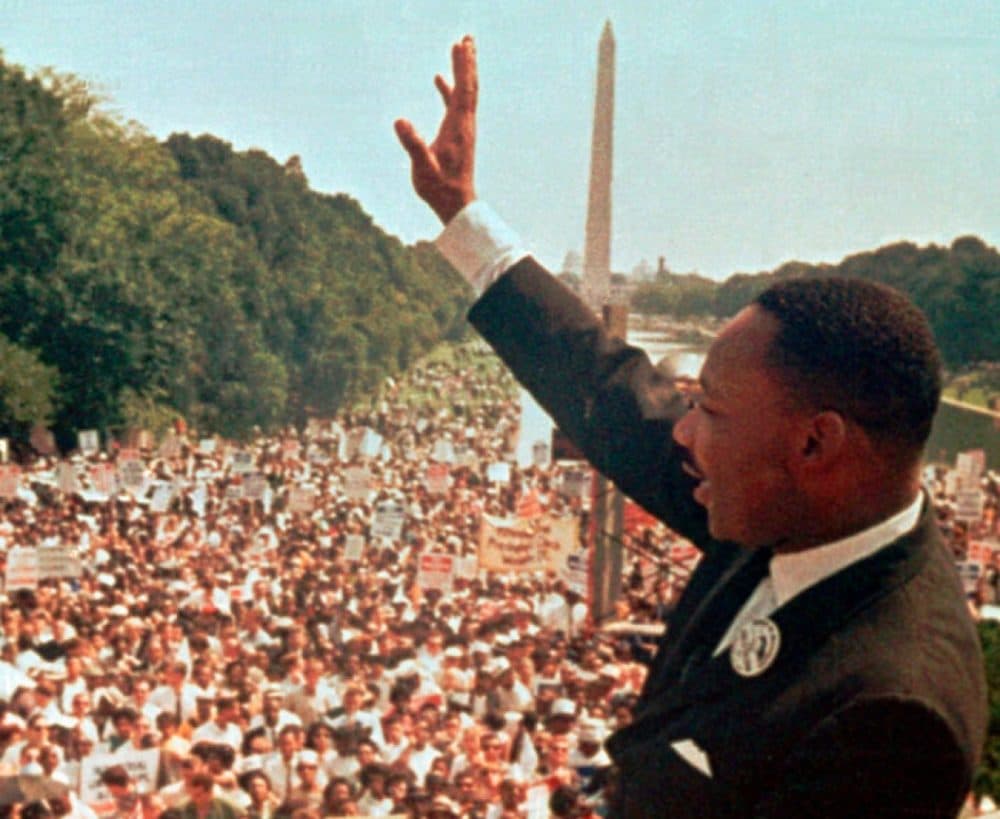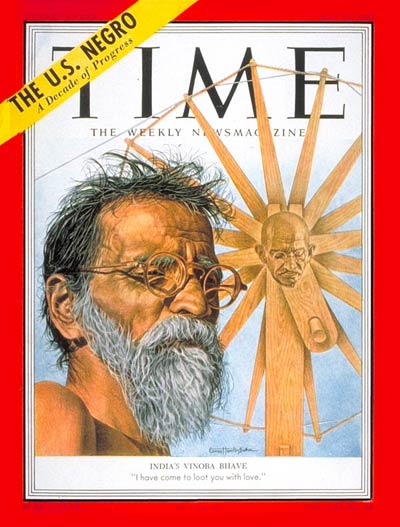
Related Links
[Today's activism is often built around an either-or logic -- my way or your way, where one way necessarily loses; in our attempts to build a bridge here, we often burn a bridge elsewhere. Heartivism, however, invites us to act from that deeper channel within us, where we are first united by our universality before we are differentiated by our particularities. A heartivist is someone who responds to the suffering of the world without needing an enemy, who unlocks the genius of nonviolence to uncover a "third way" between two "right" positions, who pushes the limits of compassion to design more infinite games that transcend the winner-loser dichotomy. Nipun Mehta's talk at the 20th annual Martin Luther King Jr. Symposium at University of Pennsylvania draws on the wisdom of Gandhi, Rev. Howard Thurman and Dr. King. Read the transcript here.]
#heartivism: Gently Shaking the World
[Talk delivered in January 2023 for the 20th annual Martin Luther King Jr. Symposium at University of Pennsylvania. The evening was graciously hosted by Symposium Committee, Office of the Chaplain and Office of the President.]
Thank you for such a heartfelt introduction. To be in the company of such inspired love-warriors from the community and to be in shared field of honoring Dr. King's legacy is a tremendous honor. Having just spent a couple of months in India, today, I'm hoping to build a bit of a Gandhi-Dr. King bridge that perhaps points us to the hem of the Infinite.
 I want to start in 1958. Dr. King was 29 years old, his first book had come out, and he was signing books in the shoe section of a department store in Harlem. A well-dressed woman wearing rhinestone glasses stepped out of the long line and shouted: “Is this Martin Luther King?” Dr. King looked up from signing copies of his first book and answered: “Yes, it is.” This woman proceeds to stab him in his chest; and rather miraculously, we have a photo of that moment. Dr. King, who still had the blade in his chest, was composed. Doctors later told him that had he sneezed, the blade could have killed him. A decade later, the night before he was assassinated, he would gloriously describe the stabbing in his famous “Mountaintop” sermon – "I’m so glad I didn’t sneeze."
I want to start in 1958. Dr. King was 29 years old, his first book had come out, and he was signing books in the shoe section of a department store in Harlem. A well-dressed woman wearing rhinestone glasses stepped out of the long line and shouted: “Is this Martin Luther King?” Dr. King looked up from signing copies of his first book and answered: “Yes, it is.” This woman proceeds to stab him in his chest; and rather miraculously, we have a photo of that moment. Dr. King, who still had the blade in his chest, was composed. Doctors later told him that had he sneezed, the blade could have killed him. A decade later, the night before he was assassinated, he would gloriously describe the stabbing in his famous “Mountaintop” sermon – "I’m so glad I didn’t sneeze."
While in the hospital that night in 1958, one of his mentors visited Dr. King -- Rev. Howard Thurman. And he offered a rather unique kind of advice: “You must deepen your channels,” or the movement will "swallow you up.” Rev. Thurman pointedly asked Dr. King to cultivate his inner transformation and unlock new resources to meet the magnitude of the moment with grace.
In reflecting on Dr. King’s life and mission, we would be remiss to not consider the nuanced and significant influence that Rev. Howard Thurman had. It is said that Martin Luther King Jr. carried Rev. Thurman’s book, “Jesus and the Disinherited” with him at all times. The back cover of his 'Meditations for the Heart' book offers this poignant introduction:
Hailed by Life magazine as one the great preachers of the twentieth century; a spiritual leader to Martin Luther King, Jr., Sherwood Eddy, James Farmer, A. J. Muste, and Pauli Murray; the first black dean at a white university; cofounder of the first interracially pastored, intercultural church in the United States; Howard Thurman (1899–1981) was a man of penetrating foresight and astonishing charisma. His vision of the world was one of a democratic camaraderie born of faith, and in light of today’s global community, one of particular importance.
Take a look at how John Lewis and others in the civil rights movement describe his importance:
It was Rev. Howard Thurman who first met Gandhi, and to whom Gandhi prophetically said, “It is through African Americans that nonviolence will spread through the world.” Feeling blessed and responsible, Rev. Thurman then inspired Dr. King to follow suit and visit India many years later, a visit that would significantly inform Dr. King's shift from strategic to principled nonviolence. Take a look:
“DEEPEN OUR CHANNELS”
In a time when our compounding catastrophes are indeed swallowing us up, Rev. Howard Thurman's question to Dr. King feels pertinent for all of us: how do we deepen our channels, ignite what Gandhi would call “Soul Force”, and become instruments for a subtler collective intelligence?
To share a potential response, I want to propose a new word: Heartivism.
Today’s activism is often built around an either-or logic -- my way or your way, where one way necessarily loses. In our attempts to build a bridge here, we often burn a bridge elsewhere. All of us understand that changing the face of the problem never amounts to progress; yet, when we feel disconnected personally, inter-personally and systemically, we play zero-sum games and fight for a bigger hammer – more money, more fame, more power – to exert our beliefs, our will, our vision onto others. Each of our wins seems to set off a ticking bomb for someone else to sort out later. Can we do better? Instead of discounting the power of inner transformation and hollowing out the depth of human connection, can we imagine a new possibility?
Heartivism, then, invites us to act from that deeper channel within us, where we are first united by our universality before we are differentiated by our particularlities. A heartivist is someone who responds to the suffering of the world without needing an enemy, who unlocks the genius of nonviolence to uncover a "third way" between two "right" positions, and who pushes the limits of compassion to design more infinite games that transcend the winner-loser dichotomy.
 Gandhi once said, “In a gentle way, we can shake the world”. It’s hard to believe that when we feel disconnected, but Martin Luther King Jr. pointed to why that works: “We are all caught in an inescapable network of mutuality, tied in a single garment of destiny. Whatever affects one directly, affects all indirectly.” As we extend our awareness of that network of mutuality, it changes the organizing principles behind our actions. Gandhi's recommendation, then, was rather counter-intuitive: if an intervention doesn’t work, try a gentler one. If even that fails, go gentler still. Today’s culture tends to equate gentle with soft, but it’s hardly so. To be gentle is to be connected, and with that awareness, we can see more and do more. When our individual flow aligns with the collective flow, an entirely new solution set emerges in the wholeness of our connection -- in the awakening of these “deeper channels” that Howard Thurman spoke about.
Gandhi once said, “In a gentle way, we can shake the world”. It’s hard to believe that when we feel disconnected, but Martin Luther King Jr. pointed to why that works: “We are all caught in an inescapable network of mutuality, tied in a single garment of destiny. Whatever affects one directly, affects all indirectly.” As we extend our awareness of that network of mutuality, it changes the organizing principles behind our actions. Gandhi's recommendation, then, was rather counter-intuitive: if an intervention doesn’t work, try a gentler one. If even that fails, go gentler still. Today’s culture tends to equate gentle with soft, but it’s hardly so. To be gentle is to be connected, and with that awareness, we can see more and do more. When our individual flow aligns with the collective flow, an entirely new solution set emerges in the wholeness of our connection -- in the awakening of these “deeper channels” that Howard Thurman spoke about.
 In South Africa, Gandhi’s primary foe was General Jan Smuts, who imprisoned him for fairly long periods. During one of those stints in the jail, Gandhi went on to hand-make a pair of sandals for the General. A gift for his captor! Years later, after Gandhi had emerged as the victor, Jan Smuts would write him a note that still stands in a musuem in South Africa, “I have worn these sandals for many a summer, even though I may feel I am not worthy to stand in the shoes of so great a man. It was my fate to be the antagonist of a man for whom, even then, I had the highest respect.” Imagine a grueling civil rights struggle over decades, and your opponent declaring, “What an honor to have you as my enemy, to lose to you!”
In South Africa, Gandhi’s primary foe was General Jan Smuts, who imprisoned him for fairly long periods. During one of those stints in the jail, Gandhi went on to hand-make a pair of sandals for the General. A gift for his captor! Years later, after Gandhi had emerged as the victor, Jan Smuts would write him a note that still stands in a musuem in South Africa, “I have worn these sandals for many a summer, even though I may feel I am not worthy to stand in the shoes of so great a man. It was my fate to be the antagonist of a man for whom, even then, I had the highest respect.” Imagine a grueling civil rights struggle over decades, and your opponent declaring, “What an honor to have you as my enemy, to lose to you!”
That’s Heartivism.
FOUR PILLARS OF HEARTIVISM
To define Heartivism more specifically, I want to identify its four foundation pillars. They draw from Gandhi’s articulation -- partly because he had 55 years to elaborate, compared to Dr. King's 12 years -- but the presence of these principles are clearly seen in Dr. King’s movement building and Rev. Howard Thurman’s teachings.
First pillar of Heartivism is what Gandhi called Swaraj. It literally translates to self-rule, and many interpreted it as independence for India, but Gandhi explained it as an awakening of an inner voice.
Rev. Howard Thurman describes this process with a great amount of specificity:
There is in every person an inward sea, and in that sea there is an island and on that island there is an altar and standing guard before that altar is the "angel with the flaming sword." Nothing can get by that angel to be placed upon that altar unless it has the mark of your inner authority. Nothing passes "the angel with the flaming sword" to be placed upon your altar unless it be a part of "the fluid area of your consent." This is your crucial link with the Eternal.
He is suggesting that reconnecting with that inward sea makes us come alive, and making an offering at that altar is what ignites our true inner voice. That inner work of calibrating our intuition is what guides our outer work. That 'crucial link with the Eternal' has to be cultivated and retained, if our service is to have a sustainable impact.
Richard Attenborough’s 1982 movie Gandhi, excellent as it was, glossed over a significant detail. Right after the impact of Gandhi’s work in South Africa, the script fast-forwards into India and the history-defining salt march. But what happened in between was silently monumental. 78 people practiced for 15 years. They lived with a deep rigor of the Ashram's 11 vows, that spanned "hands, head and heart" practice. That cultivation was the silence in the notes, the space in between the words, the iceberg below the surface. What appears uneventful was, in fact, precisely what unhooked these deeper channels – not just individually but collectively. When Tagore asks Gandhi, a few days before the salt march, “Bapu, the whole world is looking for your next move. What are you thinking?” Gandhi replies, “I don’t know, but you can be sure that I’m praying.”
Swaraj, then, invites us to attune to our inner voice while safe-guarding against our ego’s voice. Discerning signal from noise requires rigorous practice, and that nuanced intelligence is what can awaken our authentic purpose and navigate our service to the world.
Second pillar of Heartivism is what Gandhi defined as Satyagraha. This is loosely interpreted as civil disobedience, but it actually implies ‘abiding in the eternal’. It calls us to step into seeming opposition, but without losing the throughline to our fundamental oneness. Dr. King named it as a motivation "not based on resistance to get rights for ourselves, but to achieve friendship with the men who are denying us our rights, and change them through friendship."
At one point, Rev. Thurman had a neighbor who would routinely throw some food waste over the fence in his backyard. Rather skilfully, Rev. Thurman planted a tree right where this would happen. Years later, as an apple tree grew there, and the tension between the neighbors also softened, he delivered an apple pie to those very neighbors. He composted the food waste, alongside everyone’s impulsive anger.
Such propensities of the human heart are innate. It, however, can get clouded when we conflate a person’s identity with their actions. A life is much more than the sum of its actions. If we have a foundation of inner cultivation (Swaraj), we can see that our worth is not just what we do – and the measure of others isn’t merely what they might stand for in a particular moment.
Six-year-old Ruby was the first African American girl to go to an all-white school on Nov 14, 1960. All the teachers refused to teach her, except for one Mrs. Henry. Ruby received constant death threats and on the way to class every day, people would line up to shout and throw things. Mrs. Henry instructed Ruby to not speak to anyone, as she crossed the jeering crowds every day. But one day, she saw Ruby saying something, so she said, “Ruby, I told you not to speak to anyone.” “No, Mrs. Henry, I didn’t say anything to them.” “Ruby, I saw you talking. I saw your lips moving.” “Oh, I was just praying. I was praying for them,” Ruby responded. Then she recited her prayer, and I quote “Please, God, try to forgive these people. Because even if they say those bad things, they don’t know what they’re doing.”
That’s a six year old Heartivist. Indeed, Gandhi would say that if he had to learn the Law of Love, he would learn it from children!
At its core, Satyagraha makes room for us to oppose the action, but love the person. Merely opposing the action, or conflating a person’s wholeness with a misguided action, doesn’t yield any sustainable transformation. But if we can tease out the action from the largess of a person’s fundamental goodness, our resistance is enveloped by a far greater love. That connection unlocks a synergy, a "third way" between two opposing “right” positions. Serbian mystic, Gurdjieff, describes this process as the tension between a seed’s affirming force to sprout and the soil’s denying force – only to awaken a previously unimagined possibility.
Third pillar of Heartivism is Ahimsa. That’s a Sanksrit word that is typically translated as “non-violence”, but that’s a loose translation. Ahimsa is not the absence of violence, but rather, as Dr. King put it, a shift from the "darkness of destructive selfishness" to the "light of creative altruism." Below is Vimala Thakar, defining Ahimsa as an active presence of a creative love that gracefully responds to the challenges of the world.
Gandhi referred to this awakening of creative love as ‘soul force’. In 1893, when he was thrown off the train for his skin-color, Gandhi spent the entire night at the train station, shivering in the cold weather. What is curious, however, is that he didn’t call it the most traumatic night of his life; nor the most stressful. No. He would call it the "most creative night of my life." Most creative?! He opened a deeper channel of soul force.
This Soul Force isn’t a capacity that can be bottled up by an individual or a structure; it is a collective property that can only flow out collectively. Like a salt doll that gingerly steps into the ocean to risk her dissolution for a much grander belonging, Ahimsa requires a courageous reconfiguration of our identity. The very night before his passing, Dr. King emphatically declared, "It really doesn't matter to me now, because I've been to the mountain top. [...] I just want to do God's will."
When diving into this "inward sea" towards "God's will", Rev. Thurman warns of the "flaming sword" of our fight or flight reactions. Abiding in a foundation Swaraj and Satyagraha, however, a Heartivist is ready for Rev. Howard Thurman's bold new proposition: "Do not ask what the world needs. Go out and do what makes you come alive, because what the world needs most are people who have come alive." That what the world needs most are people who can wager their base impulses and salt-doll identities for the opportunity to be guided by wisdom of a benevolent Soul Force.
The most influential figure in Howard Thurman’s life was his grandmother, and this clip shares more about her invocation of such a Soul Force that transcends anything money, power or fame could deliver:
Rev. Thurman’s choice of words is quite curious. He didn’t say, "With that kind of backing, you can solve the problems of the world." No, he is saying that with such a force behind your sail, we will have the inner resources to hold adversity with equanimity – and our motivation for that principled action will become untethered from its external impact. We will be moved by love, not because of its potential to impose a certain world order, but purely by the gravity of its virtue.
Ahimsa, then, invites us to build the shoulders that hold our suffering, reconnect into a creative love, and trust in the collective flow of Soul Force.
Fourth pillar of Heartivism is what Gandhi called Sarvodaya. It means the upliftment of all, without exception.
At a cursory glance, such aspirations seem utopian. Nice lines for mission statements of nonprofit organizations, but hardly practical. In the zero-sum world we live in, we are conditioned to think that a victory for someone has to manifest as a loss for someone else.
 Martin Luther King Jr. spoke about the “fierce urgency of the now” but also how “the moral arc of the universe is long.” That ambiguity can justify just about anything – because exactly how long is “now” and how short is the long arc of the universe? Rev. Howard Thurman, fortunately, clarifies the nuance with a rather provocative anchor: “All social issues are temporary and brief. Go deep.” And Gandhi doubles down on it, even more concretely: "I do not believe in the doctrine of the greatest good of the greatest number. It means in its nakedness that in order to achieve the supposed good of 51%, the interest of 49% may be, or rather, should be sacrificed. It is a heartless doctrine and has done harm to humanity. The only real, dignified, human doctrine is the greatest good of all, and this can only be achieved by uttermost self-sacrifice."
Martin Luther King Jr. spoke about the “fierce urgency of the now” but also how “the moral arc of the universe is long.” That ambiguity can justify just about anything – because exactly how long is “now” and how short is the long arc of the universe? Rev. Howard Thurman, fortunately, clarifies the nuance with a rather provocative anchor: “All social issues are temporary and brief. Go deep.” And Gandhi doubles down on it, even more concretely: "I do not believe in the doctrine of the greatest good of the greatest number. It means in its nakedness that in order to achieve the supposed good of 51%, the interest of 49% may be, or rather, should be sacrificed. It is a heartless doctrine and has done harm to humanity. The only real, dignified, human doctrine is the greatest good of all, and this can only be achieved by uttermost self-sacrifice."
What these legends of social transformation are saying is – act now, but don’t take any shortcuts. A loss for anyone is a loss for everyone. Best short cut is, in fact, a long cut. That if you see the end game you are hoping for, you are simply playing too small a game – instead, please play a more Infinite Game. James Carse, almost 40 years ago, wrote a book called “Finite and Infinite Games” where he defined this kind of game: “A finite game is played for the purpose of winning, an infinite game for the purpose of continuing the play.”
To embrace this design challenge of an infinite game, of Sarvodaya, requires unfettered creativity -- how can I win without creating any losers? Such a question only makes sense if one has sufficient foundation of inner transformation (Swaraj), abiding in eternal (Satyagraha) and creative love (Ahimsa).
Vinoba Bhave was Gandhi’s successor in India, and someone that Gandhi held in very high regard. In a post-independence India, Vinoba gifted humanity with an unprecedented example of Sarvodaya.
 In the 1950s, seeing a lot of inequality in the country, Vinoba decides to go on a walking pilgrimage from one village to another. In each village, he would ask rich land owners, “If you had five kids, how would you distribute your land?” “One fifth to each.” “Would you adopt me as your sixth son?” Seeing his heart, people immediately agreed. And he would add, “Instead of giving me one sixth of your land, would you pass it on to your landless brother and sister in your own village here?” He ended up walking 70,000 kilometers. And more than 5 million acres of land were just donated. 5 million acres! That is bigger than the size of Kuwait. That’s twice the size of Lebanon, almost as big as Israel. No coercion, no compulsion, no loser. Just purely rooted in the virtue of generosity, compassion and connection. In 1955, when he was on the cover of Time Magazine, the caption under his photo simply read: “I’ve come to loot you with love.”
In the 1950s, seeing a lot of inequality in the country, Vinoba decides to go on a walking pilgrimage from one village to another. In each village, he would ask rich land owners, “If you had five kids, how would you distribute your land?” “One fifth to each.” “Would you adopt me as your sixth son?” Seeing his heart, people immediately agreed. And he would add, “Instead of giving me one sixth of your land, would you pass it on to your landless brother and sister in your own village here?” He ended up walking 70,000 kilometers. And more than 5 million acres of land were just donated. 5 million acres! That is bigger than the size of Kuwait. That’s twice the size of Lebanon, almost as big as Israel. No coercion, no compulsion, no loser. Just purely rooted in the virtue of generosity, compassion and connection. In 1955, when he was on the cover of Time Magazine, the caption under his photo simply read: “I’ve come to loot you with love.”
Vinoba's Bhoodan movement redistributed land, not by the might of the military or the greed of the market or the guilt of the media. It was rooted in a more infinite game -- that in giving, the rich land owners are were rewarded by their inner transformation; and in receiving, the poor land owners benefit from additional material capacity; and most importantly, by embracing the dance of giving and receiving, the entire community was richer through kinship of each other.
DESTINATION OF HEARTIVISM: JOY!
The world is seeing an unprecedented breakdown of our systems. With this rise in suffering, we are also seeing a resurgence of people responding with compassion. If as Audrey Lorde famously reminds us, “master’s tools cannot dismantle the master’s house,” we are now at a precipice where we have no choice but to “deepen our channels”, radically expand our toolkit, and respond in the spirit of Heartivism.
With Swaraj, we refine our antennas to dial into our inner voice; with Satyagraha, we compost our opposition into connection and unlock a synergistic "third way"; with Ahimsa, we dive into our inward sea and become an instrument of a collective "soul force"; and with Sarvodaya we embrace a much grander Infinite game that designs solutions that uplift all.
A heartivist, then, plays an infinite game as a skilful agent of a collective soul-force. Or simply put, someone who is moved by Love. Capital L.
And there is one simple litmus test of a Heartivist – joy. Just as Dr. King implores us to serve, Indian Noble Laureate, Rabindranth Tagore articulates a beautiful process of service: “I slept and dreamt that life was joy. I awoke and saw that life was service. I acted and behold service was joy.”
Here is a short clip of two remarkable Heartivists, who represented two different religions and world-views and whose shoulders held immense hardships of their people -- and yet, they ended on the side of profound kinship and exuberant joy.
When one of my friends was losing a lot of his martial art competitions, his sensei took him in a field one day and handed him a rock. "Use all your might and throw it as far as you can." After he did that, his teacher hands him a leaf. "Now, do the same with the leaf." Naturally, the leaf went nowhere. "If you are in a rock place in yourself, you will see a world full of dense rocks. But when you hold a leaf consciousness, you will see that your greatest strength lies in aligning with the winds of nature."
As we harmonize with those larger winds, "the inescapable network of mutuality”, we soar through the skies like the murmurations of starlings, in elegant formations divined by a collective flow that is far more intelligent than the manipulations of markets, military and mass media. When what we do is wrapped by this consciousness of mutuality, we become instruments of an eternal song of compassion -- and even our humblest acts of service carry a great roar of transformation.
Indeed, such a Heartivist shakes the world -- in a gentle way.